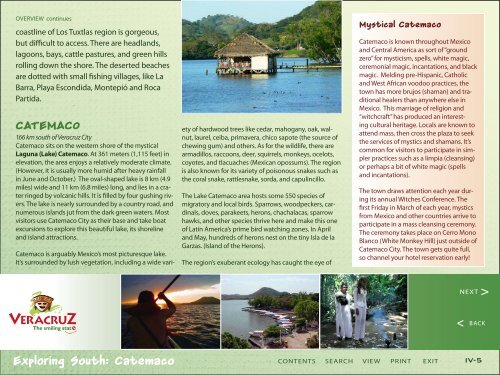Exploring Southern Veracruz State (part 4) - Veracruz-smile.com
Exploring Southern Veracruz State (part 4) - Veracruz-smile.com
Exploring Southern Veracruz State (part 4) - Veracruz-smile.com
Create successful ePaper yourself
Turn your PDF publications into a flip-book with our unique Google optimized e-Paper software.
OVERVIEW continues<br />
coastline of Los Tuxtlas region is gorgeous,<br />
but difficult to access. There are headlands,<br />
lagoons, bays, cattle pastures, and green hills<br />
rolling down the shore. The deserted beaches<br />
are dotted with small fishing villages, like La<br />
Barra, Playa Escondida, Montepió and Roca<br />
Partida.<br />
CATEMACO<br />
166 km south of <strong>Veracruz</strong> City<br />
Catemaco sits on the western shore of the mystical<br />
Laguna (Lake) Catemaco. At 361 meters (1,115 feet) in<br />
elevation, the area enjoys a relatively moderate climate.<br />
(However, it is usually more humid after heavy rainfall<br />
in June and October.) The oval-shaped lake is 8 km (4.9<br />
miles) wide and 11 km (6.8 miles) long, and lies in a crater<br />
ringed by volcanic hills. It is filled by four gushing rivers.<br />
The lake is nearly surrounded by a country road, and<br />
numerous islands jut from the dark green waters. Most<br />
visitors use Catemaco City as their base and take boat<br />
excursions to explore this beautiful lake, its shoreline<br />
and island attractions.<br />
Catemaco is arguably Mexico’s most picturesque lake.<br />
It’s surrounded by lush vegetation, including a wide vari-<br />
The smiling stat<br />
<strong>Exploring</strong> South: Catemaco<br />
ety of hardwood trees like cedar, mahogany, oak, walnut,<br />
laurel, ceiba, primavera, chico sapote (the source of<br />
chewing gum) and others. As for the wildlife, there are<br />
armadillos, raccoons, deer, squirrels, monkeys, ocelots,<br />
coyotes, and tlacuaches (Mexican opossums). The region<br />
is also known for its variety of poisonous snakes such as<br />
the coral snake, rattlesnake, sorda, and capulincillo.<br />
The Lake Catemaco area hosts some 550 species of<br />
migratory and local birds. Sparrows, woodpeckers, cardinals,<br />
doves, parakeets, herons, chachalacas, sparrow<br />
hawks, and other species thrive here and make this one<br />
of Latin America’s prime bird watching zones. In April<br />
and May, hundreds of herons nest on the tiny Isla de la<br />
Garzas. (Island of the Herons).<br />
The region’s exuberant ecology has caught the eye of<br />
Mystical Catemaco<br />
Catemaco is known throughout Mexico<br />
and Central America as sort of “ground<br />
zero” for mysticism, spells, white magic,<br />
ceremonial magic, incantations, and black<br />
magic. Melding pre-Hispanic, Catholic<br />
and West African voodoo practices, the<br />
town has more brujos (shaman) and traditional<br />
healers than anywhere else in<br />
Mexico. This marriage of religion and<br />
“witchcraft” has produced an interesting<br />
cultural heritage. Locals are known to<br />
attend mass, then cross the plaza to seek<br />
the services of mystics and shamans. It’s<br />
<strong>com</strong>mon for visitors to <strong>part</strong>icipate in simpler<br />
practices such as a limpia (cleansing)<br />
or perhaps a bit of white magic (spells<br />
and incantations).<br />
The town draws attention each year during<br />
its annual Witches Conference. The<br />
first Friday in March of each year, mystics<br />
from Mexico and other countries arrive to<br />
<strong>part</strong>icipate in a mass cleansing ceremony.<br />
The ceremony takes place on Cerro Mono<br />
Blanco (White Monkey Hill) just outside of<br />
Catemaco City. The town gets quite full,<br />
so channel your hotel reservation early!<br />
CONTENTS SEARCH VIEW PRINT EXIT<br />
NEXT ><br />
< BACK<br />
IV-5


